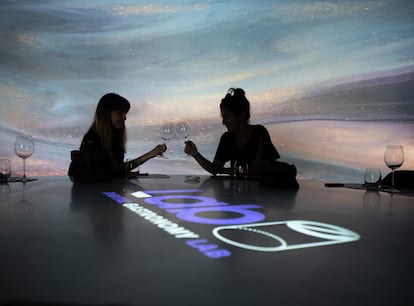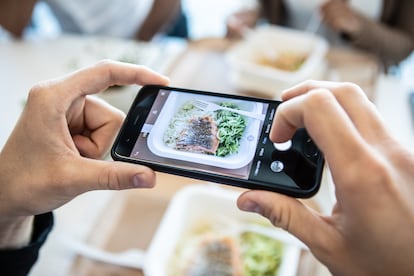From robot waiters to DNA-based menus: How AI is changing the food industry
This technology can optimize processes in a kitchen and transform the way restaurants operate. For customers, it could mean targeted menus and pricing changes in real time

Imagine going to a restaurant and the first thing you see when you enter is a screen. A camera with artificial vision detects whether you have come alone or as a couple, if you are dining as a family and whether you are a man or a woman. Based on this information, the screen offers you different menu options. If you are dining as a family, family or sharing menus will appear. Ladorian, a company specializing in Artificial Intelligence (AI) and data analysis that has been operating in Spain since 2016, is dedicated to bringing that system to restaurants. “It is proven that this type of AI increases turnover. Not all restaurants can access this type of technology, but these solutions work very well in the ones that have the [right] profile,” says Erich Eichstetter, the director of digital transformation at Basque Culinary Center Innovation in San Sebastián, in northern Spain. AI arrived in gastronomy a long time ago; this is just one example of how artificial intelligence can transform the industry.
On the one hand, AI can optimize the processes inside a kitchen, while on the other hand, it changes the way restaurants work, directly affecting the diner’s experience. “Anyone who is not using this type of solution right now is wasting time or money, which is the same thing,” says Eichstetter. AI can take care of different cumbersome tasks in a kitchen, such as the scheduling system, where reservations and their specifications can be viewed in real time. In addition, voice recognition means that a restaurant’s inventory no longer needs to be taken manually; it can be done with voice commands, and the system adjusts the inventory on its own.
According to the BCC Innovation and Delectatech’s State of the Digitization of the Hospitality Industry in Spain report, 15.93% of the Spanish hospitality industry is largely digitized and 32.41% is in the process of being digitized. Madrid, Barcelona, the Balearic Islands and Málaga are leading Spain’s digital transformation.
DynamEat is a Madrid-based startup that applies technologies that are already used in airlines and hotels to streamline pricing. “Normally, prices vary depending on the season: if it’s high [season], prices go up, and if it’s low [season], they go down. In this case, if you are in a restaurant and it is full, prices may go up a little, or the menu may be redistributed so that the dishes that come out of the kitchen fastest appear first on the digital menu, or things that are more complicated to bring out are not offered at all. In other words, everything is dynamic according to supply and demand,” says Eichstetter.
Another pioneering company is Satis.IA, which prevents errors and trains personnel to improve their productivity through AI. They manage to maintain quality standards by means of artificial vision, e.g., an alert will be triggered when a mistake is made during the preparation of a recipe or an order. NotCo, the famous Chilean plant-based product start-up company with offices in the United States, Argentina and Brazil, also stands out. It has developed its recipes using an AI algorithm called Giuseppe, which is dedicated to creating perfect combinations based on a list of vegetables to imitate flavors and textures that are identical to the animal-based products with which we are familiar.

AI–customer interactions
The customer can also derive many benefits from the implementation of Artificial Intelligence in the industry. The ability to customize taste and nutrition is one such advantage. Today, there are already different projects—especially in the United States, the United Kingdom and Japan—that involve obtaining medical information about the customer through DNA, microbiota or blood tests and use it to design a special diet or nutritional supplements. This could be quite useful for people who suffer from allergies, intolerances and dietary restrictions. Last June, BCC Innovation implemented a project where the menu revolved around the customer’s genetic profile in LaBe Restaurant in San Sebastian, Spain. Before dinner, couples were subjected to scientifically validated genetic tests developed by the IMDEA Food Institute research center in conjunction with the Autonomous University of Madrid (Spain). These studies yielded a comprehensive report that was then used to develop a personalized menu based on the customer’s DNA. These results revealed how people’s bodily processes affect their respective sports performance or aging; they also serve to prevent food intolerances and allergies.
All of this raises the question of how the public feels about the use of AI in this way. It has sparked a debate between those who think it is a wonderful tool and others who feel that their privacy has been invaded. Eichstetter argues that they are not invasive technologies, and that people are rarely aware of how they are affected. “People like personalized attention. For example, the diner still prefers to talk to the waiter taking their order at their table rather than [doing it] via a QR code, but that is something that will change over time. AI will become the new electricity. It will be in everything we do and use,” says the LaBe technology researcher.
Smart and innovative restaurants with AI
NÜA Smart Restaurant in Barcelona is one of Europe’s first smart restaurants. Its tables are tablets or touch screens where you can consult the menu, place your order and pay for it. In addition, customers can watch the news, play games and even order a cab. This type of technology is proving to optimize time, reduce errors and contribute to customer entertainment.
Robots with artificial intelligence are another technology that some restaurants already include in their offerings. The Urban Poke chain’s Pokesito is one restaurant that avails itself of this technology. The robots can deliver orders to the table as if they were waiters. They are able to offer their services at different speeds and have a microphone and speaker with which one can interact. In addition, they have the ability to avoid obstacles and, as if that were not enough, AI allows them to learn autonomously, so they can fine-tune their work routines, optimizing their efficiency.
In 2020, a Spanish startup called Haddock—led by Arnau Navarro, Pol Rosell and Carlos Marchal—developed technology with optical recognition that can recognize letters and numbers written on paper and automatically digitize them. This allows for real-time control of business expenses. La Taqueria, Miss Sushi, Guakame and Flax & Kale are some of the restaurants that have joined this wave alongside Haddock. For its part, Can Pizza, located in Madrid and Barcelona, has even offered a pizza whose recipe was developed with AI.
AI’s main goal is to optimize time and effort; if that translates into money, even better. A chef is unlikely to complain about not having to take inventories and count all the products one by one on each shelf, because there is already an algorithm that does it in a second. Right now, one of the hospitality industry’s most prevalent problems is the difficulty of reducing work hours. People are no longer willing to work 16-hour days. AI probably won’t replace humans, but it could definitely make life easier for the people working in this sector.
Sign up for our weekly newsletter to get more English-language news coverage from EL PAÍS USA Edition
Tu suscripción se está usando en otro dispositivo
¿Quieres añadir otro usuario a tu suscripción?
Si continúas leyendo en este dispositivo, no se podrá leer en el otro.
FlechaTu suscripción se está usando en otro dispositivo y solo puedes acceder a EL PAÍS desde un dispositivo a la vez.
Si quieres compartir tu cuenta, cambia tu suscripción a la modalidad Premium, así podrás añadir otro usuario. Cada uno accederá con su propia cuenta de email, lo que os permitirá personalizar vuestra experiencia en EL PAÍS.
¿Tienes una suscripción de empresa? Accede aquí para contratar más cuentas.
En el caso de no saber quién está usando tu cuenta, te recomendamos cambiar tu contraseña aquí.
Si decides continuar compartiendo tu cuenta, este mensaje se mostrará en tu dispositivo y en el de la otra persona que está usando tu cuenta de forma indefinida, afectando a tu experiencia de lectura. Puedes consultar aquí los términos y condiciones de la suscripción digital.
More information
Archived In
Últimas noticias
‘Sleepless City’: The light of cinema illuminates Madrid’s Cañada Real shantytown
All the effects of gentrification in one corner of Mexico’s Colonia Roma
Palestinian reporter Youmna El Sayed: ‘My family told me I had to choose between being a journalist or a mother’
The new language of the workplace: Knowing how to ask AI questions is more important than using it
Most viewed
- The low-cost creative revolution: How technology is making art accessible to everyone
- Christian Louboutin: ‘Young people don’t want to be like their parents. And if their parents wear sneakers, they’re going to look for something else’
- US sanctions against jailed cartel leader ‘El Marro’ highlight Mexico’s lack of control over its prisons
- Liset Menéndez de la Prida, neuroscientist: ‘It’s not normal to constantly seek pleasure; it’s important to be bored, to be calm’
- ‘El Limones’ and the growing union disguise of Mexican organized crime










































